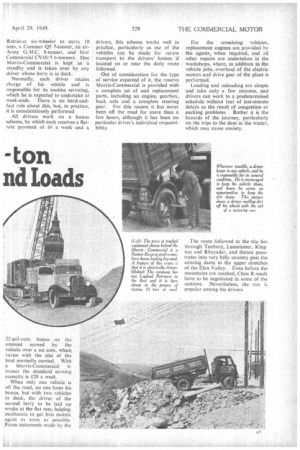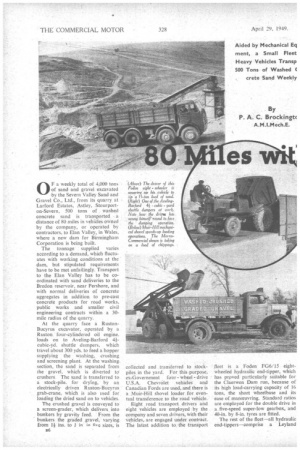ton nd Loads
Page 15

Page 14

If you've noticed an error in this article please click here to report it so we can fix it.
By P. A. C. Brockingt( A.M.1.Mech.E.
0F a weekly total of 4,000 tons -of sand and gravel excavated lay the Severn Valley Sand and Gravel Co., Ltd., from its quarry. at Larford Estates, Astley, Stourporton-Severn, 500 tons . of . washed concrete sand is transported ,.a distance of 80 miles in vehieles owned by the company, or operated by contractors, to Elan Valley, in Wales, where a new dam for Birmingham Corporation • is being built.
The tonnage' : supplied varies according to a demand, which fluctuates with working conditions at the dam, but stipulated requirements have to be met unfailingly. Transport to the Elan Valley has to be coordinated with sand deliveries to the Bredon reservoir, near Pershore, and with normal deliveries of concrete aggregates in addition to pre-cast concrete products for road works, public works and smaller civil engineering contracts within a 30 mile radius of the quarry. .
At the quarry face a RustonBucyrus excavator, operated by a Ruston . four-cylindered oil engine. loads on to Aveling-Barford 4-i-cubic-yd. shuttle dumpers, which travel about 300 yds. to feed a hopper supplying the washing, -crushing and screening plant. At the 'washingsection, the sand is separated from the gravel, which is diverted to crushers The sandis transferred to a stock-pile, for drying, by an electrically driven Ruston-Bucyrus grab-crane, which is also used for loading the dried sand on to vehicles.
The crushed gravel is conveyed to a screen-grader, which delivers into bunkers by gravity feed. From the bunkers the graded gravel, varying from li ins. to ]in in file sizs, is
B6 collected and transferred to stockpiles in the yard. For this purpose, ex-G overnment four wheel drive U.S.A. Chevrolet vehicles and Canadian Fords are used, and' there is a Muir-Hill shovel loader for eventual transference to the road vehicle.
sight road transport drivers and eight vehicles are employed by the company and seven drivers, with their vehicles, are engaged under contract. The latest addition to_ the transport fleet is a Foden FG6/15 eightwheeled hydraulic end-tipper, which has proved particularly suitable for the Claerwen Dam run, because of its high load-carrying capacity of 16 tons, the short wheelbase and its ease of manceuvring. Standard ratios are employed for the double drive in a five-speed super-low gearbox, and 40-in. by 8-in. tyres are fitted.
The rest of the fleet—all hydraulic end-tippers—comprise a Leyland Retriever six-wheeler to carry 10 tons, a Commer Q5 7-tanner, an exArmy G.M.C. 8-tonner, and four Commercial CV10/5 6-tonners. One Morris-Commercial is kept as a standby and is taken over by any driver whose lorry is in dock.
Normally, each driver retains charge of his vehicle and is responsible for its routine servicing, which he is expected to undertake at week-ends. There is no hard-andfast rule about this, but, in practice, it is conscientiously performed.
All drivers work on a bonus scheme, by which each receives a flatrate payment of £6 a week and a
25-pei-cent. bonus on the amount earned by the vehicle over a set sum, which varies with the size of the load normally carried. With a Morris-Commercial 6tonner the standard earning capacity is £20 a week.
When only one vehicle is off the road, no one loses his bonus, but with two vehicles in dock, the driver of the second lorry to be laid up works at the flat rate, helping mechanics to get him mobile again as soon as possible. From statements made by the drivers, this scheme works well in practice, particularly as use of the vehicles can be made for return transport to the drivers' homes if located on or near the daily route followed.
Out of consideration for the type of service expected of it, the reserve Morris-Commercial is provided with a complete set of unit replacement parts, including an engine, gearbox, back axle and a complete steering gear. For this reason it has never been off the road for more than a few hours, although it has been no particular driver's individual responsibility. For the remaining vehicles, replacement engines are provided by the agents, when required, and all other repairs are undertaken in the workshops, where, in addition to the vehicle jobs, overhaul of the electric motors and drive gear of the plant is performed.
Loading and unloading are simple and take only a few minutes, and drivers can work to a predetermined schedule without fear of last-minute delays as the result of congestion or packing problems. Rather it is the hazards of the journey, particularly on the trips to the dam in the winter, which may cause anxiety.
The route followed to the site lies through Tenbury, Leominster, Kington and Rhayader, and thence penetrates into very hilly country past the existing dams to the upper stretches of the Elan Valley. Even before the mountains are reached, Class B roads have to be negotiated in some of the sections. Nevertheless, the run is popular among the drivers


























